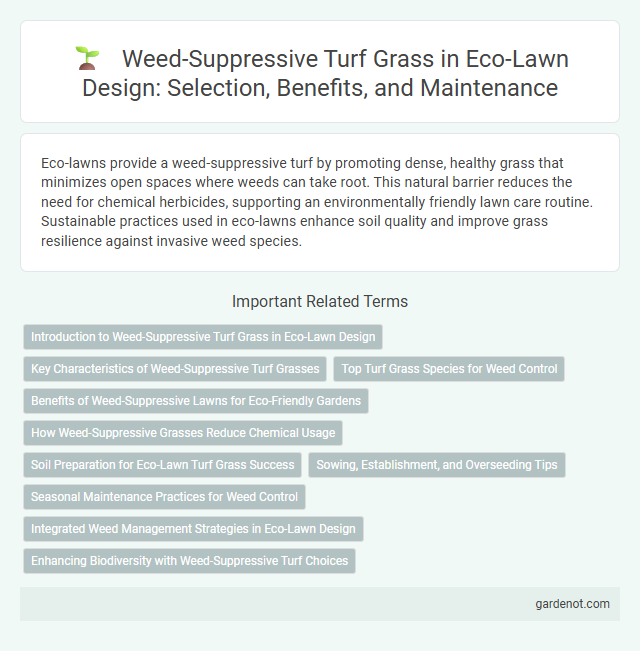Eco-lawns provide a weed-suppressive turf by promoting dense, healthy grass that minimizes open spaces where weeds can take root. This natural barrier reduces the need for chemical herbicides, supporting an environmentally friendly lawn care routine. Sustainable practices used in eco-lawns enhance soil quality and improve grass resilience against invasive weed species.
Introduction to Weed-Suppressive Turf Grass in Eco-Lawn Design
Weed-suppressive turf grass plays a critical role in eco-lawn design by naturally inhibiting weed growth through dense root systems and thick canopies. Species such as tall fescue and fine fescues exhibit allelopathic properties that reduce weed seed germination and enhance soil health. Integrating these grasses promotes sustainable lawn management by minimizing herbicide use and supporting biodiversity.
Key Characteristics of Weed-Suppressive Turf Grasses
Weed-suppressive turf grasses exhibit dense growth patterns with deep root systems that outcompete weeds for nutrients, sunlight, and water, maintaining soil health and reducing the need for chemical herbicides. Key species such as fine fescues, Kentucky bluegrass, and perennial ryegrass possess allelopathic properties that naturally inhibit weed seed germination and growth. These grasses demonstrate tolerance to mowing and environmental stress, enhancing durability and uniformity in eco-lawn applications.
Top Turf Grass Species for Weed Control
Top turf grass species for weed control include buffalo grass, Bermuda grass, and tall fescue, known for their dense growth habits that effectively suppress weeds. Buffalo grass thrives in drought-prone areas, forming a thick mat that limits weed seed germination, while Bermuda grass spreads rapidly through stolons and rhizomes, outcompeting invasive plants. Tall fescue's deep root system and tolerance to shade enhance its ability to crowd out broadleaf and grassy weeds, making it ideal for sustainable, low-maintenance eco-lawns.
Benefits of Weed-Suppressive Lawns for Eco-Friendly Gardens
Weed-suppressive lawns reduce reliance on chemical herbicides by naturally inhibiting weed growth through dense, healthy turf coverage, promoting an eco-friendly garden environment. These lawns enhance soil health and biodiversity, supporting beneficial microorganisms and pollinators while minimizing water consumption. Implementing weed-suppressive turf contributes to sustainable landscaping by lowering maintenance costs and reducing environmental pollution.
How Weed-Suppressive Grasses Reduce Chemical Usage
Weed-suppressive grasses in eco-lawns naturally inhibit weed growth by forming dense, competitive turf that limits sunlight and nutrients available to weeds, reducing the need for chemical herbicides. Species like fine fescues and buffalo grass thrive with minimal fertilizer and pesticide inputs, promoting sustainable lawn care practices. By enhancing biodiversity and soil health, these grasses minimize chemical usage while maintaining a healthy, weed-resistant lawn.
Soil Preparation for Eco-Lawn Turf Grass Success
Proper soil preparation is crucial for establishing weed-suppressive eco-lawn turf grass, involving thorough soil testing, aeration, and the incorporation of organic matter to improve soil structure and nutrient availability. Maintaining optimal pH levels between 6.0 and 7.0 promotes healthy root development and enhances turfgrass competitiveness against weeds. Effective soil preparation minimizes weed seed germination and creates an environment where eco-lawn species can thrive, ensuring sustainable and resilient turfgrass growth.
Sowing, Establishment, and Overseeding Tips
Sowing eco-lawn seed blends with weed-suppressive grasses such as fescues and fine ryegrass in early spring or fall maximizes germination and early root development. Establishment requires consistent moisture and light raking to ensure good seed-soil contact, which enhances turf density and natural weed resistance. Overseeding annually with shade-tolerant species helps maintain a thick, resilient lawn that suppresses weed growth by outcompeting invasive plants.
Seasonal Maintenance Practices for Weed Control
Seasonal maintenance practices for weed-suppressive turf include regular mowing at the recommended height of 2 to 3 inches to promote dense grass growth and prevent weed establishment. Applying appropriate seasonal fertilization supports turf vigor, enhancing its natural ability to outcompete weeds throughout spring and fall. Aeration during early fall improves soil health and root development, creating a resilient turf canopy that suppresses invasive weed species effectively.
Integrated Weed Management Strategies in Eco-Lawn Design
Weed-suppressive turf in eco-lawn design utilizes Integrated Weed Management Strategies combining dense, deep-rooted grass species with natural soil health improvement practices to reduce weed establishment. Selecting competitive grasses such as fine fescues and Kentucky bluegrass alongside regular mowing, appropriate irrigation, and organic mulching enhances turf resilience and suppresses weed growth. Incorporating ecological principles like biodiversity, soil microbiome enhancement, and minimal chemical use creates a sustainable, low-maintenance lawn ecosystem resistant to invasive weeds.
Enhancing Biodiversity with Weed-Suppressive Turf Choices
Selecting weed-suppressive turf species such as fine fescues and buffalo grass promotes a resilient lawn ecosystem by reducing chemical herbicide use and supporting diverse soil microorganisms. These turf varieties create dense, competitive ground cover that naturally inhibits weed growth, fostering habitat for pollinators and beneficial insects. Enhanced biodiversity through strategic turf selection strengthens ecosystem services, improves soil health, and contributes to sustainable landscape management.
Weed-suppressive turf Infographic

 gardenot.com
gardenot.com